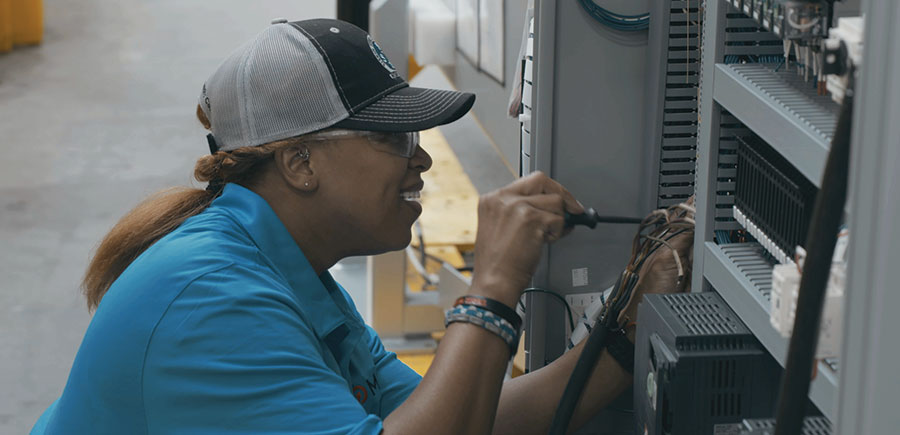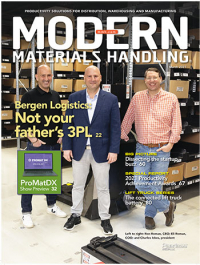CMMS takes aim at predictive maintenance
Computerized maintenance management systems are emerging as the backbone for leveraging data about materials handling equipment on the road to predictive maintenance. Key words here are: digital, data analytics and Internet of Things. If that sounds futuristic, it is. But you also need to get on board.
No one likes unpredictability. It’s unsettling. Usually disruptive. Costly, too.
But the unpredictability that most plant and DC managers would never tolerate in their processes and workflows, they often accept in maintenance. In fact, many not only live with maintenance unpredictability but almost expect it. Some go so far as to embrace it by accepting a fix-it-when-it-breaks philosophy. That’s a long way from the world of predictive maintenance most everyone agrees is the Holy Grail going forward.
Enter the computerized maintenance management system (CMMS). While not new, CMMS tends to be most prevalent in larger and newer facilities. But at all facilities where it is operating, CMMS is today very much a work in progress.
“CMMS is the first step in the path to predictive maintenance. CMMS is essential going forward,” says Diane Blair, director of field operations at Honeywell Intelligrated.
Getting to that Holy Grail is a step-wise process. A CMMS is home base for all maintenance data and activities from equipment, work orders and technician history to MRO parts management.
But to be a true maintenance hub, CMMS needs asset monitoring systems to feed it data from equipment sensors across the facility connected by an Internet of Things (IoT). Without that data, a CMMS has no way to become predictive about specific maintenance requirements of any piece of equipment or its components. That, in turn, affects its ability to schedule maintenance and execute work orders. Similarly, a CMMS needs that data to effectively manage MRO parts cost efficiently.
After talking to several experts in the field, it seems that CMMS is in the right place at the right time to substantially elevate management of the maintenance function.
“Maintenance in and of itself does not make a company money,” says Andrew Spayd, product manager of IoT and CMMS at Material Handling Systems (MHS). “However, a fully functional CMMS will go a long way to saving a company considerable money by putting predictive maintenance to work daily. It’s all about the value of good data,” he adds.
The move to digital
Don’t underestimate the value of good timing, says Leanne Peduzzi, senior vice president of life cycle services at Fortna. And in the case of CMMS, good timing has many faces.
One is the current need for greater facility flexibility to meet changing customer demands and the critical requirement to ensure business continuity, especially in times of disruption.

The most advanced systems are somewhere between a high level of preventative maintenance and a low level of predictive maintenance.
Today, facilities are trying to push through more orders in even less time to keep pace with customer demand. “The three key needs here,” says Peduzzi, “are to be proactive, timely and leverage better tools.” CMMS offers all three.
“A company can’t make money unless its assets are up and running, but most companies don’t know the costs of not being up and running,” says Tom Mullins, Dematic’s digital transformation specialist.
The big picture accelerator here is the digital transformation of companies. “People are now understanding that maintenance data is important. That’s a critical shift from thinking of data as a burden,” says Brett Webster, director of Dematic’s Digital Center of Excellence.
Webster continues to explain that this shift has helped companies to understand that maintenance is much more effective when it’s usage based not calendar based. While crossing that bridge is one a-ha moment, deciding how to manage the data about equipment usage is quite another. “CMMS is the only path to predictive maintenance,” he adds.
Webster has worked with several companies that believe in the data-based approach of CMMS managed maintenance that have several systems across their facilities. “It’s not uncommon for some of the larger companies to have six or eight CMMS solutions operating in silos at different locations in the enterprise,” says Webster.
In the past couple of years, many of those companies have made strong efforts to consolidate those maintenance systems into a single one, he explains. That consolidation provides a unified platform that uses data to manage maintenance of materials handling equipment and maximize operational and MRO parts procurement efficiencies. “Maintenance is an enabler of any company’s success,” says Mullins.
Beyond the software platform, there’s also the matter of collecting and managing data for actionable outcomes. Blair of Honeywell says the key here is an asset monitoring system (AMS). Quite simply, sensors, PLCs and other data acquisition tools are increasingly integrated with new materials handling equipment. When connected by an IoT, they feed operational data about specific pieces of equipment through an asset monitoring system to the CMMS. She describes the AMS as the icing on the CMMS cake.
Blair and others see AMS in various stage of development. While available, it is not always part of a current CMMS. However, it can be added. The general consensus is that most CMMS soltions installed today also include an AMS.
This configuration is what elevates the value of a CMMS. It provides key data not just about a conveyor but about the heat profile, for instance, of a specific motor on a specific conveyor. When a sensor picks up a heat spike, the data is fed through the system back to the CMMS. It, in turn, then generates an alert or even a work order based on the condition of the motor.
Specificity of data is critical. Spayd of MHS tells the story of the worst CMMS installation he has seen. Every conveyor in the facility was labeled in the CMMS alike. A conveyor was a conveyor without any distinguishing characteristics. “You need a good hierarchy and structure in the CMMS for it to effectively identify maintenance issues that can be addressed in a timely manner,” Spayd says.
However, there is also the danger of too much data coming in, warns Peduzzi of Fortna. The more that a CMMS can analyze rather than relying on people is preferable. She advocates a rules-based methodology that simplifies the analytics that initiate work orders and schedule repairs. However, people still remain key to managing maintenance activities today even with a CMMS in place.
As Blair points out, the most advanced systems today are generally at a point somewhere between a very high level of preventative maintenance and low level of predictive maintenance.
“We are in a middle ground between scheduling maintenance based on historical data with the assumption of a pattern and real-time condition-based predictive maintenance,” Blair says.
Managing MRO parts
With so much emphasis on just keeping equipment up and running, it’s easy to overlook the importance of CMMS to effectively manage MRO parts, says Jeff Pomerantz, founder of Tofino Software.
“Regardless of how good the software is, you’ve got to have parts available to keep equipment running,” Pomerantz points out. Making that standard practice, he adds, requires visibility into critical spares, which links directly to the procurement process.
“You need to instantly know if the right parts are on hand. If not, how can they be purchased immediately, if need be, from approved sources. It’s all about following the business rules set for managing MRO parts,” says Pomerantz.
Looking forward, he expects just-in-time procurement of spares to become increasingly important as companies more tightly manage their MRO spend. The trick, Pomerantz says, is threefold: to have enough critical parts on hand; have enough flexibility to order on a just-in-time basis; and have enough visibility into maintenance patterns to anticipate the inevitable.

A company can’t make money if its assets are not up and running. However, few companies actually know their costs of not being up and running.
Looking forward
In a way, CMMS is the vanguard of the digital transformation underway in facilities right now.
At its core, CMMS is all about collecting data over an IoT, conducting data analytics, and making the information actionable in real time. An effective CMMS leverages that data to maximize operational efficiency while being technician friendly and procurement compliant. That’s not easy.
Just as Spayd of MHS had a worst CMMS disaster, he also has a best case. The key word, he says, is collaboration. That goes for all key operations and maintenance staff, and even includes the supplier of the materials handling equipment and the CMMS itself.
Basically, CMMS requires people to work differently so teamwork is essential. “All have to buy in for CMMS to reach its potential,” says Spayd. Considering the specificity of the data needed and the impact it potentially has, that’s not surprising. But, it also needs to be said out loud.
There’s also the matter of new habits. Not the least of which is making the CMMS technician friendly. Some of that will happen naturally, says Fortna’s Peduzzi. As she points out, younger technicians are more digitally native than others further along their career path. However, CMMS needs to simplify data usage, she adds. The data can’t be mysterious to even the most digitally adept.
At the same time, no tech needs to fill out lengthy forms related to a work order. When that’s required, the data on the forms tends to suffer. The more CMMS simplifies that process, the better off all will be, Peduzzi says.
While it was said up top that CMMS tends to be most established in larger and newer facilities, the software’s usage base will continue to expand. Central will be the integration of sensors on all types of materials handling equipment, and the build out of IoT networks in facilities of all sizes. Predictive maintenance may not be here now, but CMMS is foundational to its rate of adoption.

Article Topics
MRO News & Resources
Avidbots showcases autonomous cleaning robots Traka exhibits modular lockers MRO Survey: Finding and keeping the best technicians Maintenance, Repair and Operations: Understanding the true condition of the equipment Newly formed Bison combines AMETEK DFS and Bison Gear and Engineering Corp. Building (and maintaining) your maintenance, repair and operations (MRO) tech workforce The power side of lift truck battery and charger maintenance More MROLatest in Materials Handling
Hyster recognizes Dealers of Distinction for 2023 Carolina Handling names Joe Perkins as COO C-suite Interview with Keith Moore, CEO, AutoScheduler.AI: MODEX was a meeting place for innovation Walmart deploying autonomous lift trucks at four of its high-tech DCs Coles shops big for automation Kathleen Phelps to join FORTNA as chief financial officer Coles automates grocery distribution in Australia More Materials HandlingAbout the Author
Subscribe to Materials Handling Magazine

Find out what the world's most innovative companies are doing to improve productivity in their plants and distribution centers.
Start your FREE subscription today.
April 2024 Modern Materials Handling

Latest Resources












